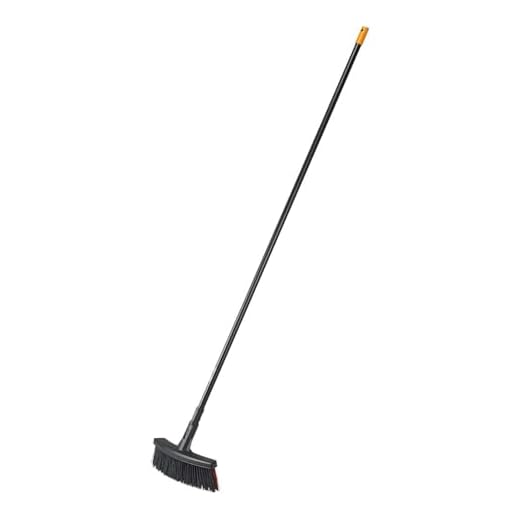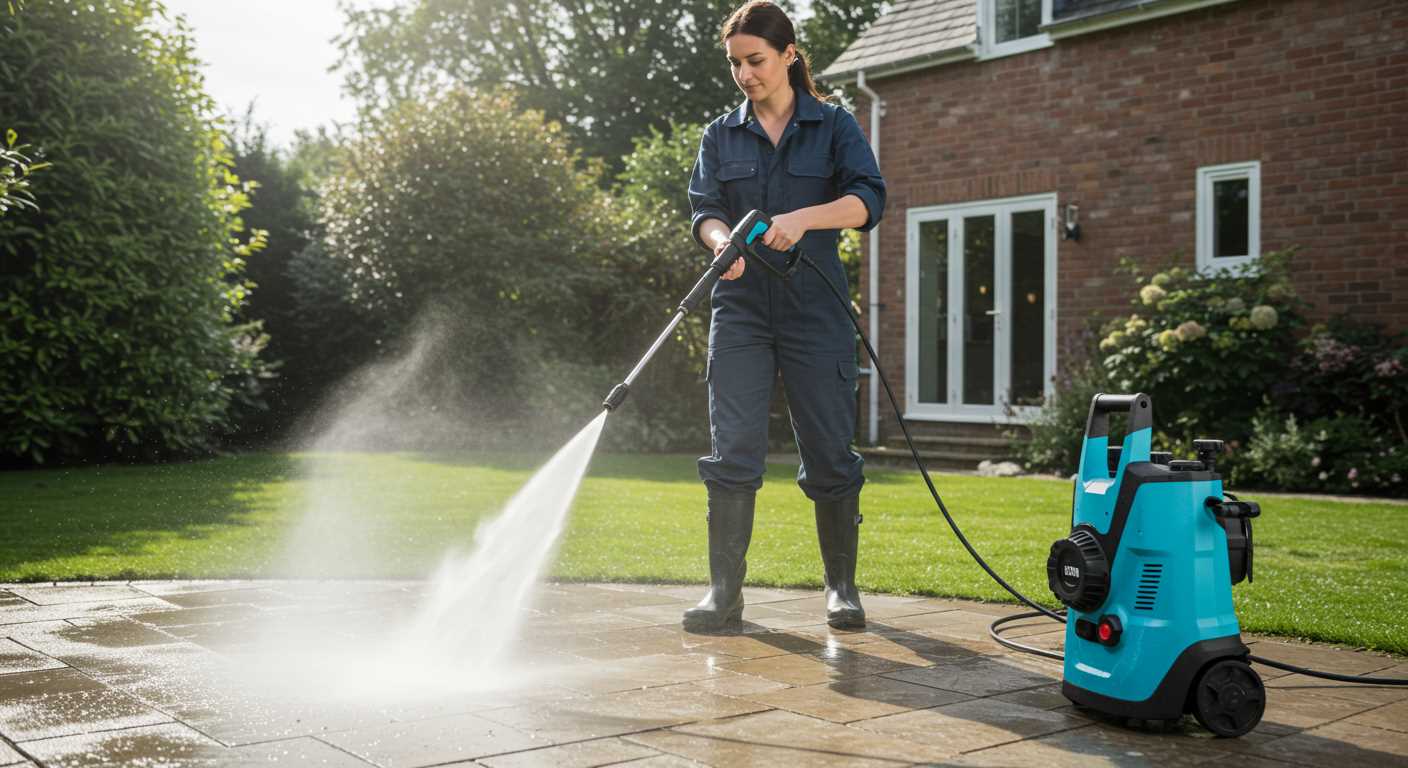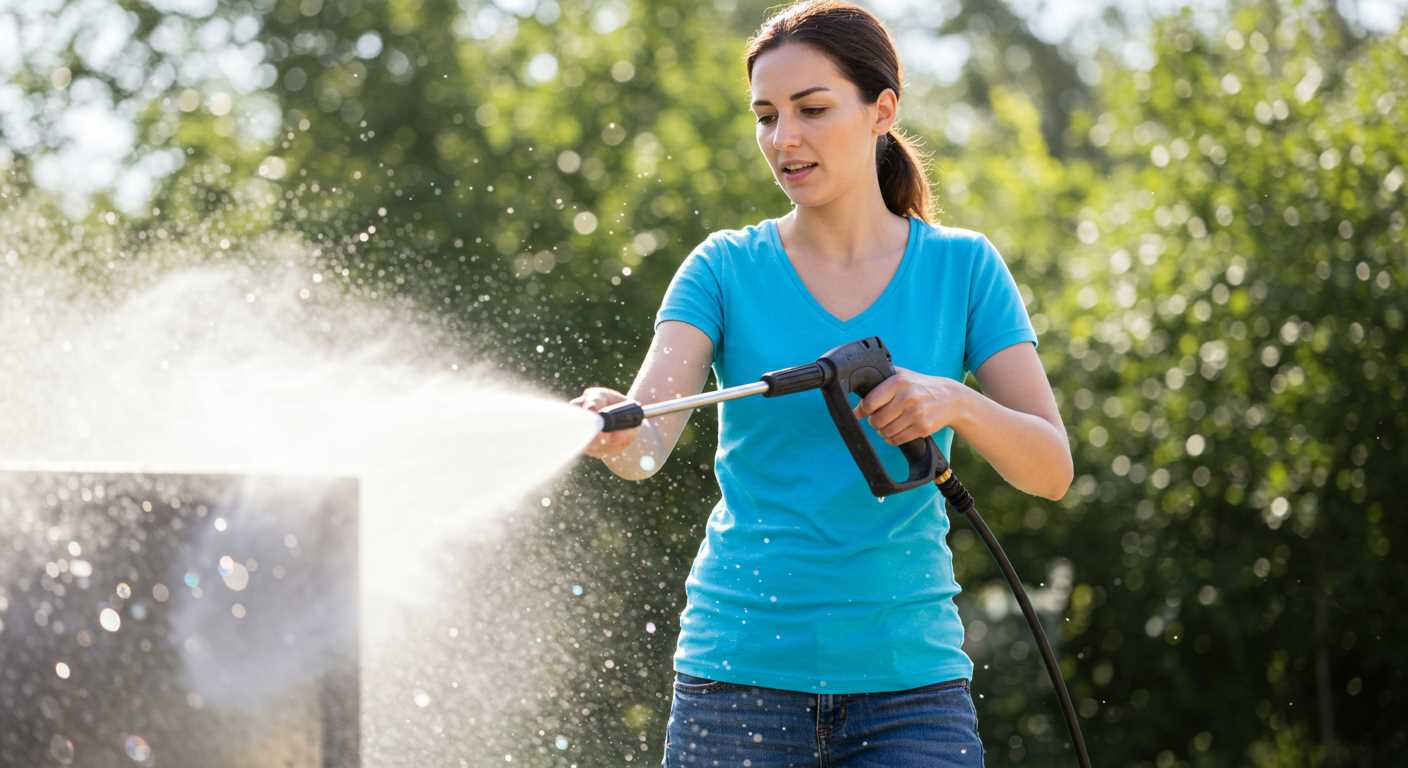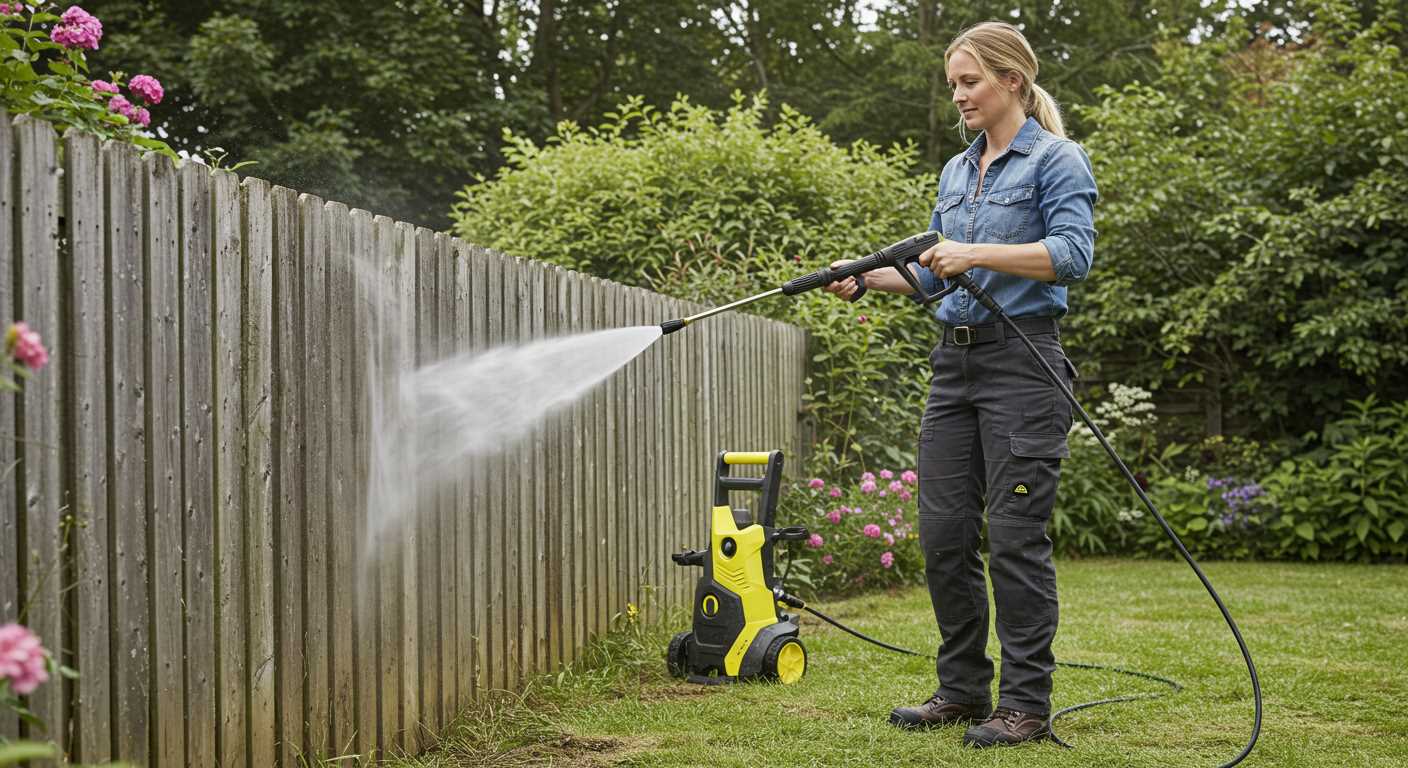



One practical approach involves using a simple mixture of water and white vinegar. This solution can effectively tackle algae and grime. Combine equal parts of each in a bucket, then apply it generously to the affected areas. Allow it to sit for about 30 minutes before scrubbing with a stiff-bristled brush.
A second method includes an oxygen bleach powder mixed with water. Unlike chlorine bleach, this option is less harsh and environmentally friendly. After dissolving the powder in warm water, apply it to the surfaces and let it rest to penetrate stubborn stains, followed by a thorough scrubbing to restore the original appearance.
Utilising a broom to sweep away loose debris is essential. Regular maintenance prevents dirt buildup, making the subsequent cleaning processes easier. For stubborn spots, a sponge or cloth soaked in soapy water can provide a gentle yet effective clean.
Finally, consider using a garden sprayer, which can apply cleaning solutions evenly across larger areas. This method saves time and effort, ensuring that every inch receives attention.
Alternative Solutions for Patio Maintenance
A mixture of warm water and vinegar is an excellent choice for tackling grime and stains on outdoor surfaces. Combine one part of vinegar with one part of water in a bucket for a natural solution that cuts through dirt effectively.
For stubborn areas, a paste made from baking soda and water works wonders. Mix three parts baking soda with one part water and apply it directly to the stained spots. Allow it to sit for about 30 minutes before scrubbing with a stiff-bristled brush.
Utilising a broom or stiff brush is crucial for removing loose debris before applying any cleaning solution. Sweep thoroughly to prevent scratching the surface when scrubbing.
For algae or mould, a solution of bleach and water may be necessary. Mix one part bleach to ten parts water and apply it carefully. Ensure proper ventilation and wear protective gear to prevent unwanted reactions.
Rinsing is just as important. Use a garden hose fitted with a spray nozzle to wash away any remaining solution and debris. Ensure to get into the crevices for a thorough rinse.
Lastly, maintaining regular upkeep after the initial clean will extend the lifespan and appearance of your outdoor area. A quick sweep and occasional spot clean can go a long way in keeping your space looking its best.
Choosing the Right Cleaning Solution for Your Patio
The selection of a suitable solution impacts the results significantly. Here are recommendations based on various materials used on outdoor surfaces:
For Concrete and Stone
- Mix equal parts white vinegar and water. This solution eliminates stains and mineral deposits.
- Baking soda combined with water creates a paste that tackles tough grime. Apply it directly to soiled areas and let it sit before scrubbing.
For Wooden Decks
- Utilise a blend of dish soap and warm water. This gentle mixture protects the integrity of the wood while removing dirt.
- A commercial deck cleaner specifically formulated for wood can effectively combat mildew and algae growth. Follow the manufacturer’s instructions carefully.
Before applying any solution, always test a small, inconspicuous area to ensure compatibility with the surface. Taking these steps maximises the effectiveness of your efforts while preserving the material beneath.
Preparing Your Outdoor Space for Maintenance

Remove furniture and other items from the area to give yourself ample room to work. This prevents any accidental damage and allows for thorough cleaning. Place these items in shaded areas to avoid heat exposure or damage during the process.
Next, sweep away debris such as leaves, dirt, and dust. Use a broom or a stiff brush to reach into crevices and corners. This step is crucial as it helps to prevent any buildup from interfering with your efforts later on.
Inspect the surface for stains, mold, or mildew. Identifying these issues early can save time during the scrubbing phase. Mark particularly troublesome areas for extra attention. You may also want to consider precise measurements of the area to determine how much cleaning solution is required.
| Item | Action |
|---|---|
| Furniture | Remove and relocate |
| Debris | Sweep thoroughly |
| Stains | Identify and mark |
| Dimensions | Measure for solution calculation |
Once the area is clear and debris-free, it’s beneficial to rinse the surface with water if possible. This can help to loosen dirt and prepare the ground for the application of any cleaning agents you plan to use.
Best Methods for Removing Stains from Patio Stones

The combination of baking soda and water creates a potent paste that effectively tackles stubborn stains. Apply the mixture to the stained area, let it sit for 15-20 minutes, then scrub with a stiff brush and rinse thoroughly.
Natural Solutions

Vinegar is highly effective against moss and mould. Mix one part vinegar with one part water, spray the solution onto the affected areas, and allow it to sit for about 30 minutes before scrubbing. This not only helps in lifting stains but also prevents regrowth.
Commercial Cleaners
There are numerous commercial solutions available specifically formulated for stone surfaces. Always choose a product that states it’s safe for the type of material you’re working with. Apply according to the manufacturer’s instructions and ensure to rinse off any residue after treatment.
| Type of Stain | Recommended Method | Details |
|---|---|---|
| Grease | Baking soda paste | Apply and scrub after 20 minutes |
| Mould | Vinegar solution | Let sit for 30 minutes before scrubbing |
| Rust | Citrus cleaner | Apply and let soak, then scrub |
| Organic stains (leaves, etc.) | Hot soapy water | Scrub with a stiff brush |
For persistent stains, consider oxygen bleach as a last resort. It’s effective for various types of stains while being gentle on surfaces. Mix according to the instructions, apply it to the stain, and scrub after the recommended time.
Using a Broom and Mop Technique for Thorough Cleaning
A sturdy broom paired with a reliable mop offers an effective approach for maintaining outdoor surfaces. Start by sweeping the area to remove loose debris such as leaves, dirt, and dust. Opt for a broom with stiff bristles to ensure all particles are dislodged from crevices.
Following the sweeping, prepare a bucket with warm water mixed with an appropriate detergent. Select a solution that is safe for the material of your outdoor space. I recommend using a mild, eco-friendly cleaner that won’t harm plants or the environment. Avoid harsh chemicals that can damage the surface.
Dunk the mop into the soapy water and wring it out to prevent excess liquid from pooling. Begin mopping in sections, focusing on one area at a time. This method ensures that the cleaner can work effectively on grime and stains. Use a back-and-forth motion to agitate the surface, allowing the detergent to lift dirt more effectively.
For stubborn marks or stains, a gentle scrubbing with a soft-bristle brush can help. After agitating the stain, mop over the area again with clean water to rinse away any remaining residue. This step is crucial to prevent slippery surfaces caused by detergent build-up.
Once the entire area is done, allow it to air dry. A thorough broom and mop technique not only keeps surfaces looking good but also extends their lifespan by preventing moss and algae build-up. Additionally, this method is safe and accessible for anyone aiming to maintain their outdoor area effectively.
Hand Scrubbing Tips for Tough Dirt and Grime
Utilise a stiff-bristled brush for the most stubborn dirt and debris. Choose one with a long handle to reduce strain on your back while scrubbing. Begin from a corner and work your way systematically to avoid missing spots.
For maximum effectiveness, apply a generous amount of your chosen cleaning solution directly to the affected area before scrubbing. Allow it to sit for at least 10-15 minutes to penetrate deeply and loosen the grime. This pre-treatment phase can significantly reduce the effort required during the scrubbing process.
To tackle mineral deposits or dried mud, use a mixture of white vinegar and water. This solution can break down the grime effectively. Keep a bucket of clean water nearby to rinse the brush frequently, ensuring you don’t simply spread the dirt around.
For corners and crevices, a smaller brush or an old toothbrush can work wonders. These tools allow for precise cleaning where larger brushes may fall short.
After scrubbing, thoroughly rinse the area with clean water. This not only removes the remaining cleaning solution but also washes away loosened dirt particles. If using a hose, opt for a gentle spray to avoid forcing dirt back into the surface.
Once the surface dries, consider applying a sealant or protective coating to extend the time between future maintenance efforts. This finishing touch can also enhance the appearance of your cleaned surface.
Using Vinegar and Baking Soda for Natural Cleaning
Mix equal parts of white vinegar and water in a spray bottle. This solution effectively targets grime and stains. Spray the mixture generously over the area needing attention.
Next, sprinkle baking soda directly onto the damp surface. The combination of these two ingredients creates a fizzing reaction that aids in breaking down stubborn residues.
Allow the mixture to sit for 10-15 minutes. This wait time enhances the cleaning action. Afterward, use a stiff-bristled brush to scrub the treated areas. Focus on any particularly dirty spots, applying extra pressure where necessary.
For rinsing, pour water over the area or wipe it down with a damp cloth to remove any remaining residue. Ensure thorough rinsing, as baking soda can leave a film if not washed away completely.
Repeat the process as needed for tough stains. This natural approach is not only effective but also environmentally friendly.
For stubborn mildew or mould, mix one cup of vinegar with two cups of baking soda and water. Apply it the same way as before and let it sit longer if required.
- Always test a small, inconspicuous area first to avoid surface damage.
- Keep the area well-ventilated when using vinegar to minimise strong odours.
- Wear gloves to protect your hands while scrubbing.
Maintaining a Clean Patio: Preventive Measures
Regular upkeep is key to keeping outdoor spaces looking their best. Implementing a few simple strategies can significantly reduce the accumulation of dirt and debris. First, place mats at entry points to minimise tracked-in grime. This simple action serves as a first line of defence against sediment.
Routine Sweeping and Inspection
.jpg)
Schedule sweeping sessions at least once a week. This keeps leaves, dust, and small debris from settling into crevices. During these sessions, it’s wise to inspect for moss or algae growth, particularly in shaded areas. Early detection allows for prompt treatment, preventing more extensive clean-up later.
Using Sealants and Coatings

Consider applying a sealant to stone or tile surfaces. A quality sealant creates a protective barrier against stains and moisture penetration. Periodic reapplication, as per the product instructions, prolongs the lifespan of materials and makes maintenance more manageable.
Additionally, encourage proper drainage around the area. Keeping gutters clean and ensuring that the ground slopes slightly away from the patio prevents standing water, which can promote unwanted growth and degradation of surfaces.
By integrating these proactive measures into my routine, I’ve noticed a remarkable reduction in the effort required to keep external areas tidy and inviting.
FAQ:
What are some effective methods to clean my patio without using a pressure washer?
There are several methods to clean your patio without a pressure washer. One simple approach is to use a mixture of warm water and dish soap. Apply the solution with a stiff broom or scrub brush, focusing on stained or dirty areas. For tougher stains, consider using a paste made from baking soda and water, which can be scrubbed onto the surface and left to sit for a while before rinsing off. Another option is to use white vinegar, as it acts as a natural disinfectant and stain remover; combine it with water in a spray bottle, then spray and scrub your patio. For an eco-friendly solution, you can also use a mixture of baking soda and vinegar, allowing it to fizz before scrubbing. After cleaning, rinse the patio thoroughly with water to remove any residue.
Is it necessary to use special cleaning products for patio cleaning, or can I use common household items?
Using common household items for cleaning your patio is not only feasible but can also be quite effective. Many people opt for solutions like vinegar, baking soda, or dish soap, which are readily available and safe for most patio materials. These ingredients can tackle dirt, grime, and even some stains without causing damage. Special cleaning products may offer specific benefits, such as targeted stain removal or surface protection, but they are often not required for routine cleaning. If you choose to use a commercial cleaner, make sure it’s suitable for the type of material your patio is made from—like stone, concrete, or wood—to avoid any adverse effects. Always test any product or solution on a small, inconspicuous area first to ensure compatibility.










